Review: Galway and Cliffs of Moher day tour
With Galway’s affluent Irish history and the soaring coastal Cliffs of Moher, Ireland’s west coast boasts stunning views and vibrant culture, says Marcela Guimaraes.
Standing on the edge of the Cliffs of Moher looking down at the 214m (702ft) drop as waves crash onto the rocky shore below, I realise I have to face my fears. Suffering from a fear of heights, I know I have to take this moment to face the almighty, and what better place to do so than one of Ireland’s most beautiful sites. I take a deep breath, inch myself up to the edge, and sit down. As my feet dangle in the Atlantic Ocean breeze, I feel the exhilarating sense of accomplishment.
I had started the day boarding the Dublin Tour Company express shuttle in Dublin, on which we headed west through stunning Irish countryside boasting vast stretches of bright green pastures dotted with grazing cattle. Two and a half hours later, we were in Galway eagerly anticipating our walking tour.
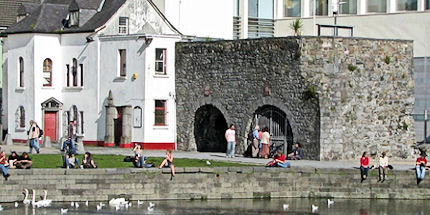 The stone Spanish Arch on the banks of the River Corrib
The stone Spanish Arch on the banks of the River CorribCreative Commons / beamillion
Latin Quarter
Known as the "city of tribes", Galway is full of rich Irish culture and historical significance. We set off exploring the lively Latin Quarter, where we briefly stood to the side of the River Corrib and listened to the history of the Spanish Arch. Adjacent to the arches stands a white building with red-rimmed windows and doors, once home to Clare Sheridan, the famous sculptress and cousin of Sir Winston Churchill.
As we walked down the cobblestone streets serenaded by traditional Irish music escaping from the bars, our guide pointed out brightly coloured buildings with windows and doors trimmed in contrasting colours, explaining this influence was from survivors of the Spanish Armada that was blown off course on its return home. Here, each building has its own historical claim, including Thomas Dillon Claddagh Gold (1 Quay Street), the original makers of the traditional Irish Claddagh rings; and the Kings Head Pub (15 High Street), that was appropriately named after one of its tenants, the executioner of King Charles I.
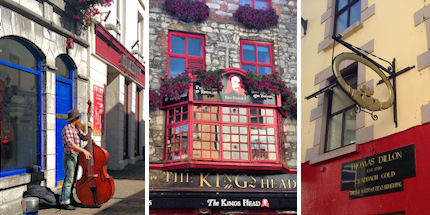 Galway's lively Latin Quarter
Galway's lively Latin QuarterMarcela Guimaraes
Medieval Centre
In the heart of the medieval centre, we stopped at St Nicholas Collegiate Church (Market Street), the oldest building in the city and Ireland's largest medieval parish. Christopher Columbus is said to have prayed there in 1477 before sailing to discover the New World; while during the takeover of Oliver Cromwell's army, much of the church's interior was destroyed and several of its rock statues remain broken and headless.
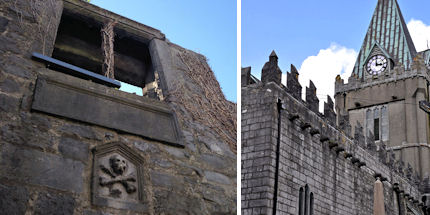 St Nicholas Church and the spooky Lynch Memorial Window
St Nicholas Church and the spooky Lynch Memorial WindowMarcela Guimaraes / Creative Commons / Jennifer Boyer
At the side of the church is the Lynch Memorial Window. Embedded on a stone façade above a Gothic doorway carved with a skull and bones, the vine and moss covered window has an eerie feel. As legend goes, the mayor of Galway, James Lynch Fitz Stephen, condemned his son after he confessed to murdering a Spanish sailor who had reportedly romanced his girlfriend. When no one would execute him, the mayor took it upon himself to ensure justice prevailed. Although the word "lynch" claims many origins, the Irish will tell you it originated from this tale.
Burren
We soon visit The Burren, a karst-landscape region home to more than 90 megalithic tombs, passing the villages of Kinvara and Kilfenora with their famous Celtic crosses. On the way, our tour guide regaled us with local Gaelic sayings, such as fáilte (welcome) and sláinte (cheers).
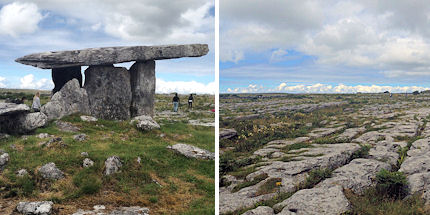 The Burren landscape and the Poulnabrone dolmen
The Burren landscape and the Poulnabrone dolmenMarcela Guimaraes
We stop briefly at Poulnabrone dolmen, a portal tomb made out of limestone slabs dating back to the Neolithic period. The actual tomb is roped off, but I could still get fairly close it – although it was hard to get a picture without an errant hand or head in shot from the hordes of tourists. But on the way up winding hills, our guide pointed out picture-worthy sites such as the Corcomroe Abbey, a 13th-century monastery, and the Ballyalban Fairy Fort, a prehistoric ring fort with mythical Irish folklore origins of fairies and leprechauns. We have lunch at the pretty coastal village of Doolin, home to the Doolin Chocolate Shop (Fisherstreet) that enticed me in with the scent of homemade fudge.
Craggy Cliffs of Moher
We arrived at the Cliffs of Moher around midday. The 8km-long (5 miles) landscape has stunning views and near vertical rock-edged drops down to the ocean. It was a beautiful day on the cliffs, with clear blue skies and a refreshing August breeze – and, for a place that rains 250 days out of the year, we were lucky it was dry. Sadly, the pretty Atlantic puffins are only in the area while nesting in April and May.
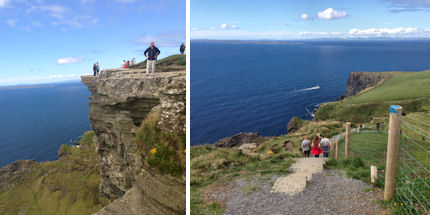 Stroll along the winding coastal walkway
Stroll along the winding coastal walkwayMarcela Guimaraes
In need of stretching my legs, and with around 90 minutes to explore, I decided to face my vertiginous fear and head to O’Brien’s Tower (where for €2 you can climb up to the top and get a higher view), and on to the highest point of the cliff. Walking along the coastal edge of the cliff, I felt as though I was walking on top of the world.
Now, as I sit on the edge, all I can see is miles of blue ocean before me. I spread my arms out wide and take in the ocean breeze – living in a city you sometimes forget what fresh air actually smells like. The experience leaves me elated, knowing I can conquer my trepidation to experience one of the most beautiful views I’ve ever seen.
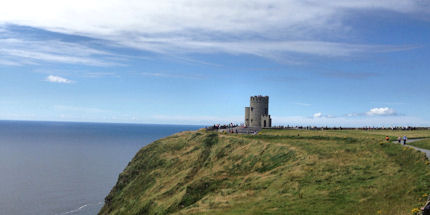 O'Brien's Tower, the highest point at the Cliffs of Moher
O'Brien's Tower, the highest point at the Cliffs of MoherMarcela Guimaraes
Ideal for…
Anyone wanting a trip from Dublin to Ireland’s alluring west coast to see all the famed sights in one day. Not ideal for children, as it’s a long trip.
Worth the price?
Return tickets from Dublin cost €45, including admission to the cliffs (€40 students and seniors). But you can also choose a one-way ticket for €35 and stay in Galway. The variety and number of sights make the tour good value for money and the guides are informative.
Room for improvement:
The majority of the 14-hour trip was spent on the bus, so it could be a little monotonous at times. A lot of sights were passed while on the bus, so depending on which side you were sitting on, you could miss out – it would have been nice to have got off the bus to see more sights in person. Lunch is not included in the price.
Tips:
It’s a long day trip and there is only one lunch break, so bring lots of snacks. Be sure to stay alert and look out for the sights out of the window. If you have more time, choose the overnight tour (€75), where you have two days of touring with accommodation at a hostel included.
Rating:
4/5
Details:
Starting point: Pick up is at the Discover Ireland Centre on Suffolk Street.
Times: Departs Dublin at 7am and returns at 9pm.
Price: Return tickets: €45 for adults, €40 for students and seniors.
Website: www.dublintourcompany.com/dtc/daytours.jsp
Do you have any Feedback about this page?
© 2025 Columbus Travel Media Ltd. All rights reserved. No part of this site may be reproduced without our written permission, click here for information on Columbus Content Solutions.









 You know where
You know where